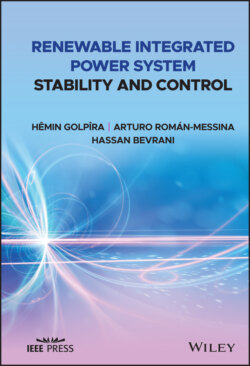Читать книгу Renewable Integrated Power System Stability and Control - Hassan Bevrani - Страница 20
1.2.3 Oscillation Damping
ОглавлениеTraditionally, the power system oscillations are damped through the generator local controllers, such as the exciter and governor, which are designed to ensure only the local stability of the generator (1–2 Hz). In order to increase the stability of the system, PSSs and power electronic converter‐based FACTS are added into the grid [99–101]. In a broader context, the power system oscillation problem has also been related to voltage stability. The control interaction is discussed in [102, 103]. The exploitation of the wide‐area measurements, provided by PMUs, for monitoring and controlling the power system led to the introduction of the wide‐area monitoring and control (WAMC) systems [104]. The advent and application of synchronized measurement technology has enabled the detection and observation of poorly damped oscillations (such as the inter‐area modes) and became the backbone for more development of the WAMC systems [105]. Inter‐area oscillations are characterized by low frequency (0.2–1 Hz) and occur when generators of one group swing against generators of another group [106]. Integration of RESs into the WAC scheme for damping power oscillations is discussed in [107, 108]. The utilization of a networked control system model for the WAC design, according to linear matrix inequality techniques, is proposed in [111]. Furthermore, Ref. [110] presents a WAC design, based on particle swarm optimization, for improving the performance of the power system through the control of wind farms.
More specifically, WAC aims to utilize the synchronized phasor measurements in order to provide coordination signals to the local controllers, making them capable of damping effectively all the inter‐area oscillations [100]. In the literature, various works deal with the development of a WAC system. The proposed WAC schemes are segregated mainly according to the components of the power system that the WAC is intended to coordinate [3, 110]. Multiple control methodologies have been developed for damping the inter‐area oscillations deploying a WAMC. In [83], a decentralized/hierarchical architecture for wide‐area damping control using PMU remote feedback signals was discussed. References [100, 111] proposed the design of wide‐area damping controllers that provide supplementary damping control to synchronous generators (SGs). A networked control system model for wide‐area closed‐loop power systems is applied in [109]. A power oscillation damping controller is introduced in [112] based on a modal linear quadratic Gaussian methodology. A combination of controlling SGs and renewable sources in order to increase the overall damping capability of the system is shown in [101, 107, 108, 113]. Few LPV control solutions to power oscillation damping are proposed that use either a low‐order first principle model of the system [114] or a reduced‐order parametric LPV identified model [115].
In comparison of frequency and voltage control, a higher number of reports have been published in PMU‐based oscillation damping (rotor angle control) field. However, most of the reported approaches require the detailed and accurate knowledge of the complete network model (both topology and parameter values), that is unavailable or corrupted in practice as a result of communication failures, bad data in state estimation etc. In addition, the impact of disturbances on the inter‐area oscillations cannot be well captured by these methods.
